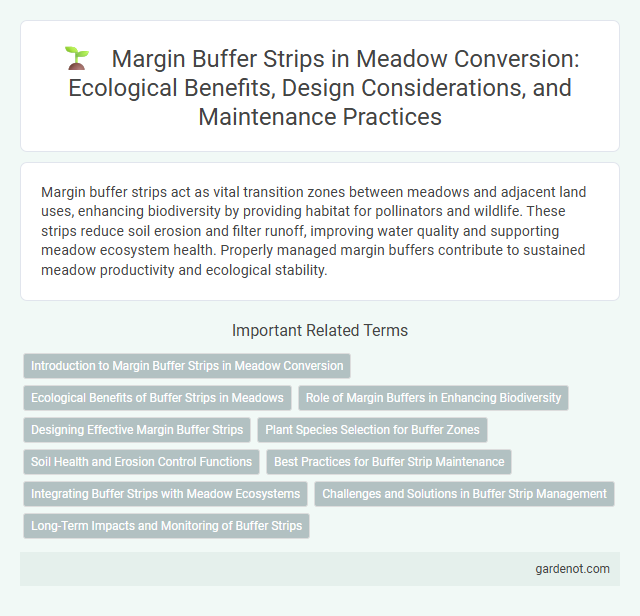Margin buffer strips act as vital transition zones between meadows and adjacent land uses, enhancing biodiversity by providing habitat for pollinators and wildlife. These strips reduce soil erosion and filter runoff, improving water quality and supporting meadow ecosystem health. Properly managed margin buffers contribute to sustained meadow productivity and ecological stability.
Introduction to Margin Buffer Strips in Meadow Conversion
Margin buffer strips in meadow conversion serve as critical transitional zones that protect ecosystem health by filtering runoff, reducing soil erosion, and enhancing biodiversity. These strips consist of native grasses and wildflowers planted along field edges, creating habitats for pollinators and beneficial insects. Effective implementation of margin buffer strips contributes to sustainable land management and improved water quality in agricultural landscapes.
Ecological Benefits of Buffer Strips in Meadows
Margin buffer strips in meadow conversion serve as vital ecological corridors that enhance biodiversity by providing habitat for pollinators and other beneficial insects. These strips improve soil health by reducing erosion and filtering runoff, which supports cleaner waterways and promotes nutrient cycling. Buffer strips also create microhabitats that increase plant diversity and contribute to ecosystem resilience against climate stressors.
Role of Margin Buffers in Enhancing Biodiversity
Margin buffer strips play a critical role in enhancing biodiversity by providing transitional habitats between agricultural fields and natural ecosystems. These strips help to reduce soil erosion, filter pollutants, and create corridors for wildlife movement, thereby supporting diverse plant and animal species. Maintaining margin buffers contributes to healthier ecosystems by fostering habitat connectivity and improving overall landscape heterogeneity.
Designing Effective Margin Buffer Strips
Designing effective margin buffer strips involves selecting native vegetation that enhances biodiversity while stabilizing soil and filtering pollutants from runoff. The optimal width typically ranges from 10 to 30 feet, balancing ecological benefits and land use efficiency. Strategic placement along water bodies and field edges maximizes ecosystem services such as habitat connectivity and water quality improvement.
Plant Species Selection for Buffer Zones
Selecting diverse native plant species for margin buffer strips enhances ecosystem resilience by supporting pollinators and soil health. Including deep-rooted grasses and flowering perennials aids in nutrient absorption and erosion control along meadow edges. Prioritizing species adapted to local soil and moisture conditions optimizes the effectiveness of buffer zones in meadow conversion projects.
Soil Health and Erosion Control Functions
Margin buffer strips play a crucial role in enhancing soil health by filtering runoff and trapping sediments, thereby preventing nutrient loss and maintaining soil fertility. These vegetated zones stabilize soil structure, reducing erosion by absorbing excess water and minimizing surface runoff velocity. Effective implementation of margin buffer strips supports sustainable meadow conversion by safeguarding soil integrity and promoting ecosystem resilience.
Best Practices for Buffer Strip Maintenance
Maintaining margin buffer strips in meadow conversion involves regular mowing to prevent woody plant encroachment and promote biodiversity, ideally after the nesting season to safeguard wildlife. Periodic removal of cuttings ensures nutrient levels remain low, discouraging invasive species and supporting native flora. Monitoring soil moisture and erosion helps optimize strip effectiveness in filtering runoff and protecting adjacent habitats.
Integrating Buffer Strips with Meadow Ecosystems
Margin buffer strips play a crucial role in integrating meadow ecosystems by acting as transitional zones that enhance biodiversity and reduce nutrient runoff into adjacent waterways. These vegetated strips support pollinators and wildlife, creating habitat connectivity between meadows and surrounding landscapes. Properly designed buffer strips improve soil health and water quality, reinforcing the ecological resilience of meadow environments.
Challenges and Solutions in Buffer Strip Management
Margin buffer strips face challenges such as soil erosion, nutrient runoff, and invasive species encroachment that compromise meadow conversion efforts. Effective buffer strip management involves tailored planting of deep-rooted native vegetation to stabilize soil and absorb excess nutrients. Regular monitoring and adaptive maintenance strategies help address invasive species and ensure optimal ecological function.
Long-Term Impacts and Monitoring of Buffer Strips
Margin buffer strips play a crucial role in meadow conversion by reducing nutrient runoff and improving water quality in adjacent ecosystems. Long-term impacts include enhanced biodiversity, soil stabilization, and sustained habitat connectivity for pollinators and wildlife. Continuous monitoring through vegetation surveys and water quality assessments ensures the effectiveness and adaptive management of buffer strips over time.
Margin buffer strip Infographic

 gardenot.com
gardenot.com